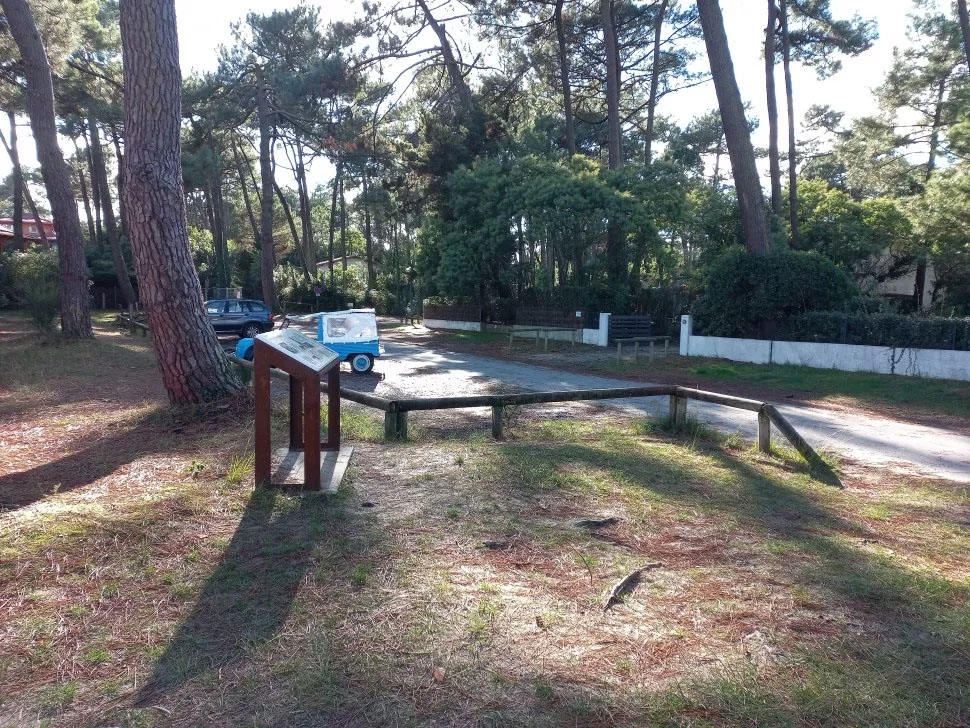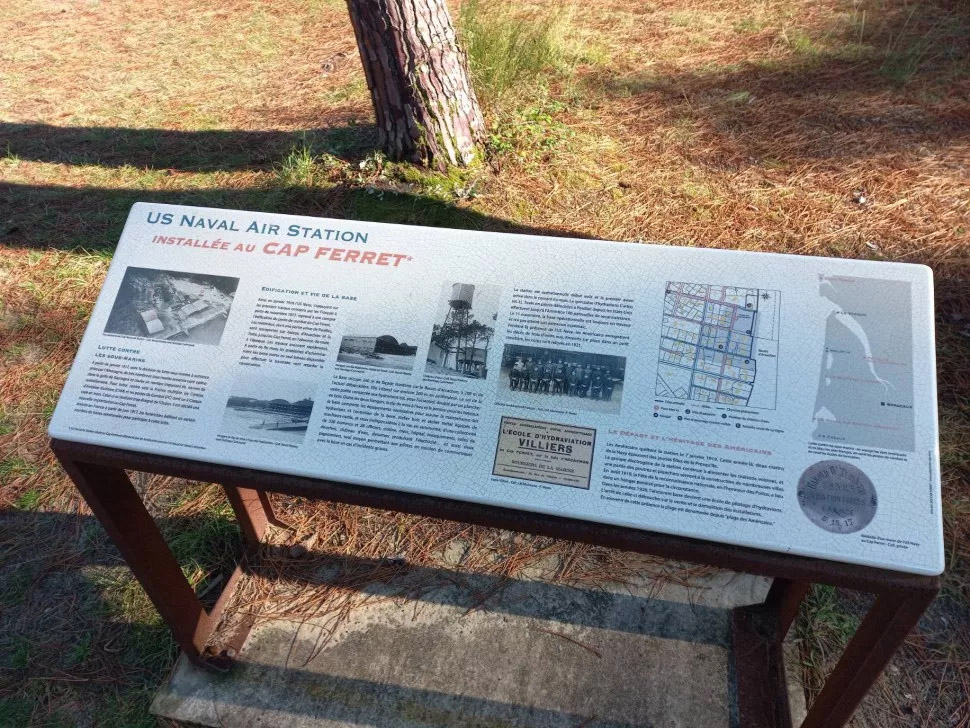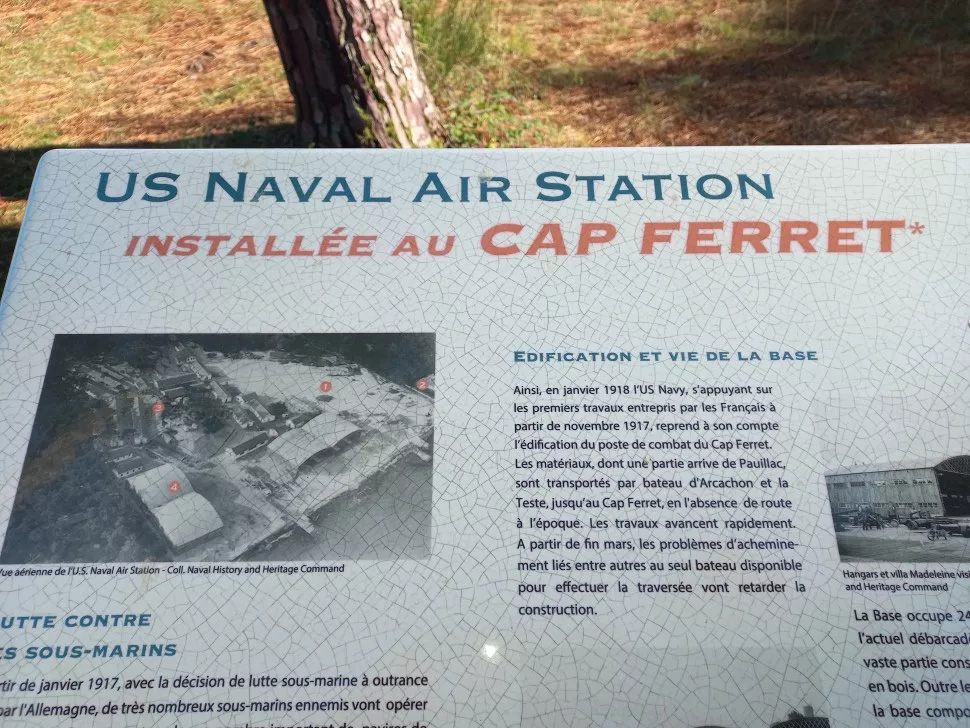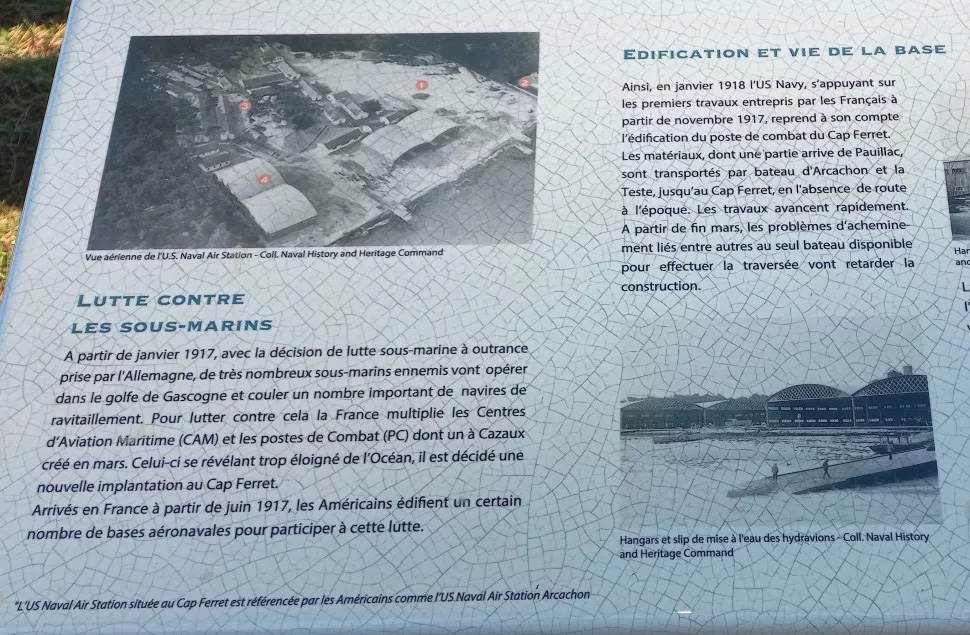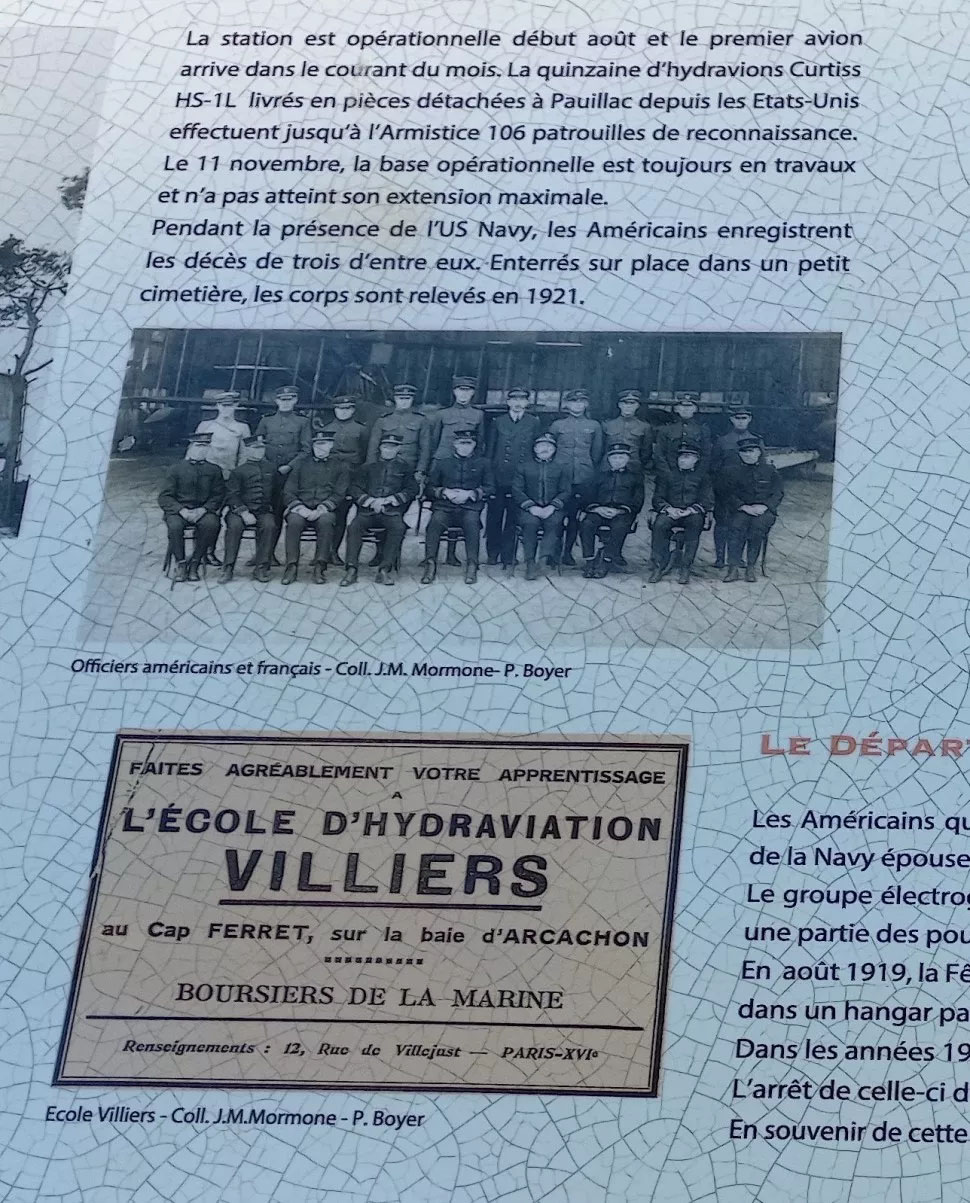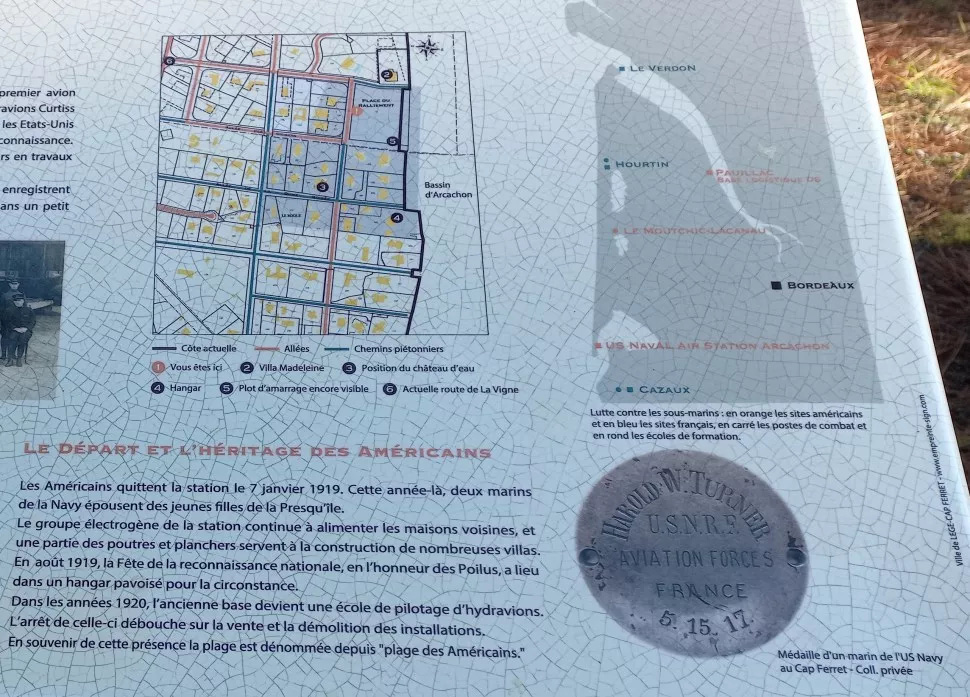Cap Ferret U.S. Naval Air Station Info Sign
Details:
Next to the car park.
A wide rectangular board containing the history of the naval air station. The inscription is written in French in printed lettering. The info sign also features various images. The history is from the establishment of the naval base until the departure of the Americans.
Monument Text:
(Note: The transcription is not complete. Only the captured close-up portions of the info sign are transcribed.)
US NAVAL AIR STATION
INSTALÉE AU CAP FERRET
(-image here-)
Vue aérienne de l'U.S. Naval Air Station - Coll. Naval History and Heritage Command
LUTTE CONTRE
LES SOUS-MARINS
A partir de janvier 1917, avec la décision de lutte sous-marine à outrance prise par l'Allemagne, de très nombreux sous-marins ennemis vont opérer dans le golfe de Gascogne et couler un nombre important de navires de ravitaillement. Pour lutter contre cela la France multiplie les Centres d'Aviation Maritime (CAM) et les postes de Combat (PC) dont un à Cazaux créé en mars. Celui-ci se révélant trop éloigné de l'Océan, il est décidé une nouvelle implantation au Cap Ferret.
Arrivés en France à partir de juin 1917, les Américains édifient un certain nombre de bases aéronavales pour participer à cette lutte.
L'US Naval Air Station située au Cap Ferret est référencée par les Américains comme l'US Naval Air Station Arcachon
EDIFICATION ET VIE DE LA BASE
Ainsi, en janvier 1918 l'US Navy, s'appuyant sur les premiers travaux entrepris par les Français à partir de novembre 1917, reprend à son compte l'édification du poste de combat du Cap Ferret. Les matériaux, dont une partie arrive de Pauillac, sont transportés par bateau d'Arcachon et la Teste, jusqu'au Cap Ferret, en l'absence de route à l'époque. Les travaux avancent rapidement. A partir de fin mars, les problèmes d'acheminement liés entre autres au seul bateau disponible pour effectuer la traversée vont retarder la construction.
(-image here-)
Hangars et slip de mise à l'eau des hydravions - Coll. Naval History and Heritage Command
La station est opérationnelle début août et le premier avion arrive dans le courant du mois. La quinzaine d'hydravions Curtiss HS-1 L livrés en pièces détachées à Pauillac depuis les Etats-Unis effectuent jusqu'à l'Armistice 106 patrouilles de reconnaissance. Le 11 novembre, la base opérationnelle est toujours en travaux et n'a pas atteint son extension maximale.
Pendant la présence de l'US Navy, les Américains enregistrent les décès de trois d'entre eux. Enterrés sur place dans un petit cimetière, les corps sont relevés en 1921.
(-image here-)
Officiers américains et français - Coll. J.M. Mormone- P. Boyer
|
FAITES AGREABLEMENT VOTRE APPRENTISSAGE
A L'ÉCOLE D'HYDRAVIATION VILLIERS au Cap FERRET, sur la baie d'ARCACHON ••••••• BOURSIERS DE LA MARINE
Renseignements : 12, Rue de Villejust — PARIS-XVIe
|
Ecole Villiers - Coll J.M. Mormone - P. Boyer
(-map here-)
LE DÉPART ET L'HÉRITAGE DES AMÉRICAINS
Les Américains quittent la station le 7 janvier 1919. Cette année- là, deux marins de la Navy épousent des jeunes filles de la Presqu'île.
Le groupe électrogène de la station continue à alimenter les maisons voisines, et une partie des poutres et planchers servent à la construction de nombreuses villas. En août 1919, la Fête de la reconnaissance nationale, en l'honneur des Poilus, a lieu dans un hangar pavoisé pour la circonstance.
Dans les années 1920, l'ancienne base devient une école de pilotage d'hydravions. L'arrèt de celle-ci débouche sur la vente et la démolition des installations.
En souvenir de cette présence la plage est dénommée depuis "plage des Américains."
(-map here-)
Lutte contre les sous-marins : en orange les sites américains et en bleu les sites français, en carré les postes de combat et en rond les écoles de formation.
(-image here-)
Médaille d'un marin de l'US Navy au Cap Ferret - Coll. privée
English translation:
US NAVAL AIR STATION
INSTALLED IN CAP FERRET
(-image here-)
Aerial view of the U.S. Naval Air Station - Coll. Naval History and Heritage Command
FIGHT AGAINST
SUBMARINES
From January 1917 onwards, with the decision taken by Germany to wage an all-out submarine war, many enemy submarines operated in the Bay of Biscay and sank a large number of supply ships. To fight against this, France multiplied the number of Maritime Aviation Centers (MAC) and the Combat Posts (CP), including one in Cazaux, established in March. This one proved to be too far from the ocean, so it was decided to set up a new one at Cap Ferret.
After arriving in France in June 1917, the Americans built a number of naval air bases to participate in this battle.
The US Naval Air Station located at Cap Ferret is referred to by the Americans as the US Naval Air Station Arcachon
EDIFICATION AND LIFE OF THE BASE
Thus, in January 1918, the US Navy, building on the initial work undertaken by the French in November 1917, took over the construction of the Cap Ferret battle station. The materials, some of which came from Pauillac, were transported by boat from Arcachon and La Teste to Cap Ferret, since there was no road at the time. The work progressed rapidly. From the end of March onwards, the problems of transport, linked to the only boat available to make the crossing, delayed the construction.
(-image here-)
Hangars and seaplane launching bays - Coll. Naval History and Heritage Command
The station was operational at the beginning of August and the first aircraft arrived later that month. The fifteen or so Curtiss HS-1 L seaplanes delivered in parts to Pauillac from the United States carried out 106 reconnaissance patrols until the Armistice. On 11 November, the operational base was still under construction and had not reached its maximum extension.
During the presence of the US Navy, the Americans recorded the deaths of three of their own. Buried on-site in a small cemetery, the bodies were recovered in 1921.
(-image here-)
American and French officers - Coll. J.M. Mormone- P. Boyer
|
HAVE A PLEASANT LEARNING EXPERIENCE
AT THE SCHOOL OF HYDRAVIATION VILLIERS at Cap FERRET, on the bay of ARCACHON ------- SCHOLARS OF THE NAVY
Enquiries : 12, Rue de Villejust - PARIS-XVIe
|
Ecole Villiers - Coll J.M. Mormone - P. Boyer
(-map here-)
THE DEPARTURE AND LEGACY OF THE AMERICANS
The Americans left the station on January 7, 1919. That year, two Navy sailors married young girls from the Presqu'île.
The station's generator continued to supply the neighboring houses, and some of the beams and floors were used in the construction of numerous villas. In August 1919, the National Recognition Day, in honor of the Poilus, was held in a hangar decorated with flags for the occasion.
In the 1920s, the old base became a seaplane pilot school. The stop of this one leads to the sale and the demolition of the installations.
In memory of this presence, the beach has been named "American beach".
(-map here-)
Anti-submarine warfare: in orange the American sites and in blue the French sites, in square the combat stations and in round the training schools.
(-image here-)
Medal of a sailor of the US Navy in Cap Ferret - Private collection

